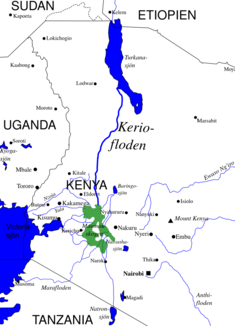Kerio
| Kerio | ||
|
Course of the river |
||
| Data | ||
| location |
|
|
| River system | Kerio | |
| source | on the northern slopes of the Amasya Hills | |
| muzzle | in Marsabit County in Lake Turkana Coordinates: 2 ° 59 ′ 16 " N , 36 ° 10 ′ 29" E 2 ° 59 ′ 16 " N , 36 ° 10 ′ 29" E
|
|
The Kerio is a river in the Rift Valley . It flows northward into Lake Turkana . It is one of the longest rivers in Kenya and has its source near the equator .
course
The Kerio rises on the northern slopes of the Amasya Hills in the west of Lake Bogoria . It flows north through the Kerio Valley between the Tugen Hills and the Elgeyo Escarpment . The Elgeyo Escarpment towers over 1,830 meters above the Kerio Valley in places. The Kerio continues on its way north, often through deep and narrow valleys, and flows into Lake Turkana in a delta, which lies south of the delta formed by the Turkwel and Lokichar rivers . In its lower reaches, the Kerio is seasonal.
Land use
The Lake Kamnarok National Reserve and the Kerio Valley National Reserve are in the upper valley on the eastern and western side of the Kerio. They are undeveloped, but have a diverse bird life and are known for their landscape. The left bank of a 25-kilometer stretch of the river lies in the South Turkana National Reserve. In Turkana County , the main sites for irrigated agriculture are on the banks of the Turkwel and Kerio. The Lotubai and Morulem irrigation systems are on the Kerio. Mainly maize and millet , which make up 80 percent of the irrigated crops, as well as mung beans , cowpeas , bananas , mangoes , oranges and guavas are grown .
literature
- Mary Fitzpatrick, Tom Parkinson, Nick Ray: East África . Lonely Planet, 2006, ISBN 1-74104-286-0 ( limited preview in Google Book Search).
- RH Hughes, JS Hughes: A directory of African wetlands . IUCN, 1992, ISBN 2-88032-949-3 ( limited preview in Google Book Search). }
- Kalweo: Parliamentary Debates . December 7, 1999, Dumping of Toxins into River Keria ( limited preview in Google Book Search).
- DJ Watson, J. van Binsbergen: Livelihood diversification opportunities for pastoralists in Turkana, Kenya . ILRI (alias ILCA and ILRAD), 2008, ISBN 92-9146-210-1 ( limited preview in Google book search).
